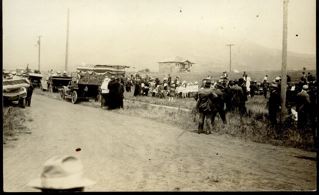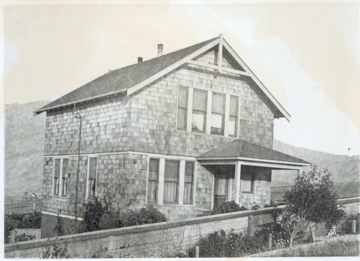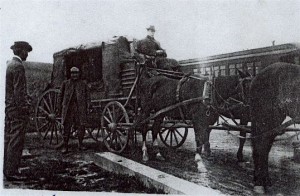Are these celebrating folks looking at the lone house in the background? Is the second photo the same house? And is it the “Wheeler House?”
In 1992 I received snail mail from Marjorie Borda. “Is the ‘Wheeler House’ still standing in Montara,” she asked me. “And, if so, who lives there?”
The area was called Farallone when Marjorie Borda was born in the Wheeler House in 1912. Marjorie’s dad, Williard Scott, was the Ocean Shore Railroad’s Farallone station agent and Scott wanted to buy the home.
As a little girl, Marjorie played with the Abbott children who lived in the “Abbott House.” She wondered, “Are any of the Abbotts still living in Montara?”
There’s more to this story, and it involves a strange coincidence as well as lives that overlap.
Years ago, while making an historic presentation, I met Marjorie Borda. Later, at another presentation, I met Laura Taylor. Marjorie and Laura did not know each other but I wish they had. Both their fathers worked as station agents for the Ocean Shore with one succeeding the other at beautiful Tunitas Glen, the end of the line.
For more than a decade, the ambitious but ill-fated railroad linked Tunitas Glen with San Francisco. At Tunitas Creek, passengers got off the train, and those headed for Santa Cruz, were picked up by a Stanley Steamer. Looking at an old photo, Marjorie identified the driver as Jim Frye. She said the brakeman was Harry Staples.
Laura Taylor’s father, Ralph Wall, was 35 when he was assigned to the station at Tunitas in 1912. Ralph, his pregnant wife, and youngest daughter, Louise, arrived to find that their new home “was a two-room tar paper shack.” The warehouse filled with crates of Coastside artichokes stood next door—and a few yards away was a sign that read, “Saloon,” belonging to Sybil Easterday and husband Louis Paulsen.
Dr. Brooke, of Half Moon Bay, delivered the Wall’s daughter, Katherine, and Laura was born in 1917.
“When Katherine was born, Mr. Randall, the assistant manager of the railroad,” Laura told me, “sent my folks a telegram of congratulations. He asked if she would be called ‘KT,’ with the ‘T’ as her middle name, standing for Tunitas where she was born.” Mr. Randall’s wish was granted and Laura’s older sister was called Katherine Tunitas Wall.
Louise, the eldest was five years old, when the family was invited in 1913 to a special dinner party at the Tunitas Glen home of the eccentric sculpturess Sybil Easterday.
(An arty menu created by Sybil was given to me by Laura–and I gave it to the San Mateo County History Museum in Redwood City.)
A 1979 letter from Louise to me gives us a rare glimpse of Sybile. Louise visited the Easterday home built before the 1906 earthquake frequently.
“I know the Easterday family in Redwood City was well educated,” she said. “The windows of the house looked out on the creek and there was a lovely harp in the bay window. The harp fascinated me. To hear Sybil play it, made me want to learn how.”
Sybil’s tale of how her father tried to get out of bed during the 1906 earthquake seemed hysterically funny to the precocious five-year-old. “Sybil’s tale made it sound as if her father was drunk.”
(and maybe he was!)
Although Sybil “could be a lady when she wanted to be,” Louse best remembered the artist for her “salty language.”
When Katherine Tunitas was born, Sybil’s first comment was, “Another brat to take of.”
“My father said one time he had a telegram to deliver to Sybil. He was almost to the house when he heard her swearing so he turned around quietly and went back a ways, then started back for the house whistling. I never heard my dad swear. He seldom even took a dirnk.”
In 1914, the Ralph Wall family left Tunitas Creek. Ralph went to work for the Ocean Shore Railroad at the Moss Beach, Granada and Half Moon Bay stations while earning extra money driving a jitney during the 1915 Panama-Pacific International Exposition in San Francisco.
The Wall’s daughters, Ella and Laura, were born in 1916 and 1917 respectively in the Half Moon Bay train station. “The depot that I was born in,” Laura Taylor told me, ” is [was] part of the Methodist Church.”
Williard Scott, Marjorie Borda’s dad, got his railroad education early. He was 14 when he left his home in Arkansas, earning a living selling peanuts on trains, always sending his paycheck home to his mom. He learned Morse Code in Denver, then traveled to San Francisco where he met his future wife, Jennie Francis.
To support his new family, Williard worked as a telegraph operator for the Ocean Shore Railroad. He was in his mid-30s when he began work as a station agent at the Farallone Depot, and it was then that the family moved into “the Wheeler House.”
Spontaneous landslides at Devil’s Slide often delayed the train in those early days. On one occasion Marjorie’s dad drove his horse and cart to rescue her brother who was stranded on an idle train.
When little Marjorie moved to Tunitas in 1914, her mother worried about the “gypsies” who lived nearby. “She was afraid they were going to steal me,” Marjorie said.
“I can still remember the smells of the beach, the smells from the different plants.” With a deep sigh, she described the delicious dinners at an Italian farmer’s house. “There was a long family style table and on it was vino, watered down for the children, formaggio and pane.”
After the 1906 earthquake, the railroad began to fail financially–and it never recovered.
In 1919 the Ralph Walls left Half Moon Bay for San Francisco where Ralph worked at a gas station. Eventually the Williard Scott family moved on.
When Marjorie Borda visited Tunitas Creek in the 1960s, the old train station was still there. “My brother-in-law knocked on the station door, and a little old man came out and he remembered my father, Mr. Scott, the station agent.”



